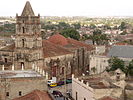Wikipedia:Today's featured list/June 27, 2011
Nine locations from the Caribbean island-nation of Cuba have been designated as World Heritage Sites by the United Nations Educational, Scientific and Cultural Organization (UNESCO). They are considered places of importance to cultural or natural heritage as described in the UNESCO World Heritage Convention, established in 1972. Cuba accepted the convention on March 24, 1981. Of the nine sites, two have been selected for their natural significance: Alejandro de Humboldt National Park in the eastern provinces of Holguín and Guantánamo, and Desembarco del Granma National Park, named for the yacht that carried the members of the 26th of July Movement, who started the Cuban Revolution. City landscapes include Old Havana, Trinidad, and Camagüey (pictured), all founded by early Spanish colonists in the 16th century. The sites include two historical agricultural regions: the coffee plantations of southeastern Cuba and the tobacco region of Viñales Valley. (Full list...)

